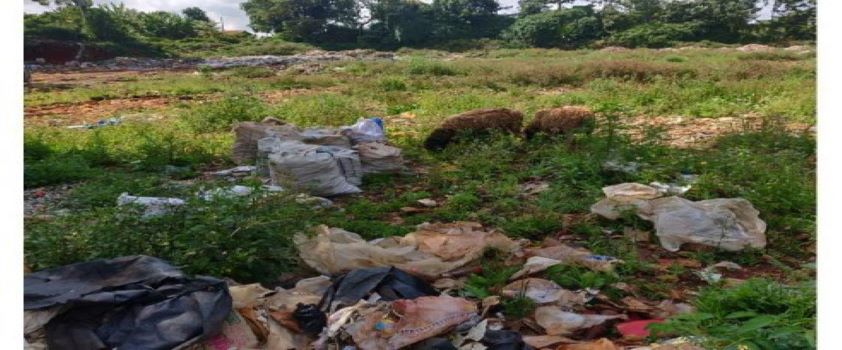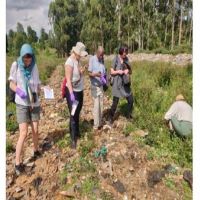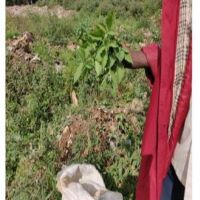
Solid waste governance approaches to reduce conflicts and promote human and environmental health in Othaya Sub-county
Overview
Quantities of solid waste generated by the rapidly urbanizing municipalities, towns and market centres in Kenya far outstrips the management capacities of the county governments leading to degraded environments that endanger lives, the 2 environment and social order. This study was carried out as part of the experiential learning platforms conducted annually by the Wangari Maathai Institute for its postgraduate students. It was carried out for the second time in Othaya sub-county of Nyeri south. It highlights (1) the types and sources of solid waste which is brought to Gikeu dumpsite in Karima ward, (2) solid waste governance in Nyeri county and how this affects solid waste management in Othaya sub-county, (3) the environmental and socio-economic impacts of dumping solid waste at the Gikeu dumpsite, (4) the importance of adopting the minimum requirements for solid waste management as spelt out in the National Solid Waste Management Strategy, (5) the need to enhance solid waste management capacity and, (6) the importance of ensuring adequate public participation in solid waste management to reduce social discontent and disorder.
Solid waste management in Kenya
Solid waste management in Kenya is well anchored in several policy and legal frameworks such as the Constitution of Kenya (2010), Article 42 and Part 2 of the Fourth Schedule which provides that the County Governments shall be responsible for refuse removal, refuse dumps and solid waste disposal. In Vision 2030, one of the flagship projects is the solid waste management initiative. The Environmental Management and Coordination Act (EMCA), 1999 makes provisions and regulations regarding solid waste management. Other relevant laws include the Occupational Safety and Health Act, 2007; The Public Health Act, 2012; the Urban areas and Cities Act, 2011 and the County Governments Act, 2012 among others. Due to the existing poor waste management facilities within the 47 counties, NEMA has developed minimum requirements for management of the existing waste management facilities to promote continuous compliance with the waste management regulations in the counties (NEMA, 2014). The minimum requirements focus on waste collection, transportation, disposal and licensing (NEMA, 2014). The strategy further states that the “The County Governments will strive to ensure continuous improvement of collection methods, transportation and disposal facilities. Effective waste management systems will deliver a clean and healthy environment for all as granted by the Constitution of Kenya, 2010”.
The Gikeu Dumpsite Study
Nyeri County, like many other counties in Kenya, is facing daunting challenges in the management of solid waste generated in the municipalities, towns and market centres. This has generated public protests in such places like Karindundu dumpsite in Mathira constituency and Gikeu dumpsite in Karima ward in Othaya Sub-county. The bone of contention is transboundary movement and dumping of waste at inappropriate and poorly managed sites leading to considerable environmental and human health problems. In March, 2020, postgraduate students and staff from The Wangari Mathai Institute for Peace and Environmental Studies (WMI) and the Danish Universities of Copenhagen and Roskilde1 carried out a study themed on the environmental and socio-economic impacts of solid waste ma nagement at Gikeu dumpsite in Karima ward, Othaya sub-county. Gikeu dumpsite is a low lying area prone to flooding with the surface and subsurface water draining into nearby Thuti river. It covers an area of 0.69 ha. The dumpsite is approximately 25 years old. The solid waste is brought mainly by the county trucks from diverse sources in Nyeri county.
nagement at Gikeu dumpsite in Karima ward, Othaya sub-county. Gikeu dumpsite is a low lying area prone to flooding with the surface and subsurface water draining into nearby Thuti river. It covers an area of 0.69 ha. The dumpsite is approximately 25 years old. The solid waste is brought mainly by the county trucks from diverse sources in Nyeri county.
The study involved identifying the stakeholders of Gikeu dumpsite and their roles, the sources and types of waste streams entering Gikeu dumpsite, the management of the dumpsite and perceptions of the community around the dumpsite regarding impacts of dumping solid waste at Gikeu in Karima ward. Eight key informant interviews and a focus group discussion were conducted at the study site. A questionnaire involving thirty four households around the dump site was administered. Plant and soil samples were taken from representative sites for analysis of heavy metals and water samples for E. coli, nitrates and other contaminants2. The study also involved collection and analysis of secondary data and information.
 The activities at the dumpsite included active dumping of waste by county council employees, solid waste collection for recycling purposes, children playing in the area, fodder harvesting for livestock, people walking across the dumpsite and along the adjacent road, harvesting of edible plants for food and herding of sheep, goats and cows. On site, visible waste included assorted electronic waste, electrical wires, discarded batteries, plastic waste, broken pipes, and compact discs. There were also organic market waste, condoms, shaving razors, metallic nails, polystyrene foams, artificial hair, nail polish bottles, wine bags, leather shoes, aluminum foils, mattress pieces, clothes, cement bags, car tires, used diapers, metal cans, used sanitary pads, broken glass, glass bottles and medical sharps. Animals at the dumpsite included dogs and livestock. Butterflies, frogs, ants, swallows, Hadada ibis (Bostrychia hagedash) and other birds were also present. Plants growing at the site included African nightshade, pumpkin, tomatoes, potatoes, amaranth and eucalyptus trees.
The activities at the dumpsite included active dumping of waste by county council employees, solid waste collection for recycling purposes, children playing in the area, fodder harvesting for livestock, people walking across the dumpsite and along the adjacent road, harvesting of edible plants for food and herding of sheep, goats and cows. On site, visible waste included assorted electronic waste, electrical wires, discarded batteries, plastic waste, broken pipes, and compact discs. There were also organic market waste, condoms, shaving razors, metallic nails, polystyrene foams, artificial hair, nail polish bottles, wine bags, leather shoes, aluminum foils, mattress pieces, clothes, cement bags, car tires, used diapers, metal cans, used sanitary pads, broken glass, glass bottles and medical sharps. Animals at the dumpsite included dogs and livestock. Butterflies, frogs, ants, swallows, Hadada ibis (Bostrychia hagedash) and other birds were also present. Plants growing at the site included African nightshade, pumpkin, tomatoes, potatoes, amaranth and eucalyptus trees.
The key findings of the study were:
- The study results showed that the dumpsite was not secured with a fence and a gate manned by a county government official. Waste brought to the dumpsite spills into 0.24 ha of private property and a public road. The waste is not properly spread, covered and compacted at regular intervals.
- Solid waste management is a devolved function according to the Kenya Constitution, 2010. The National Environment Management Authority provides guidelines for solid waste management as well as monitoring and enforcement. The resources required for solid waste management in the county are limited. The nested institutional framework scrambles to action only after protests from the public and their response has not been adequate to resolve the problems associated with the dumpsite.
- Presence of E. coli (Escherichia coli) bacteria in water at the dumpsite and in a well close to the dumpsite. E. coli bacteria are known to cause intestinal infections.
- Nitrate levels measured in water samples from three wells around the dumpsite did not meet the national standard of 10 mg/L. It is difficult to pinpoint the sources of nitrates as there are many possibilities but they may include seepage from fertilized soils and refuse dumps.
- 64% of the respondents were very dissatisfied with the management of the dumpsite. The main reasons for this were lack of secure fence, the location of the dumpsite and unkept promises of relocation of the dumpsite
- Although burning of solid waste has reduced, 68% of the respondents experience smoke emanating from the dumpsite while 97% of the respondents reported experiencing foul smell from the dumpsite.
- 50% of the households near the dumpsite experience noise which comes the county trucks especially when it gets stuck in the waste during the rainy season.
- 94% of the respondents reported discomfort living close to the dumpsite. They reported several health-related problems which they believed were due to the presence of the dumpsite. 79% of the respondents believe their health is negatively affected by the dumpsite.
- Several homes in the vicinity of the dumpsite were deserted. Also a rather high frequency of graves was observed in most homesteads. The community attributed the two observations to the dumpsite.
- A church has been abandoned due to flooding and foul smell from the Gikeu dumpsite.
Conclusion
The Gikeu dumpsite is located in an inappropriate site that is prone to flooding and in the middle of a highly populated area. The management of the dumpsite falls far short of the guidelines provided in the national solid waste management strategy. Consequently, the county government has not adhered to the Constitution of Kenya, Article 42 which provides that “Every person has the right to a clean and healthy environment” which includes the right to intergenerational equity and other rights specified in the cited article. Public participation in the management, protection and conservation of the environment is enshrined in the Constitution but decisions about the location and continuous operation of the dumpsite appear to be top-down with the local communities voices being unheard or ignored. We recommend a change of attitude for the betterment of the Gatugi community and the environment.
Recommendations
We recommend that the County Government of Nyeri adopts the minimum requirements for solid waste management in all sub-counties with supporting policies in place (waste segregation, recycling, payment for services etc.) . To be able to do this, it will be necessary to ensure adequate capacity and a well-planned and functional solid waste management infrastructure. More importantly, the county should ensure meaningful public participation in the management of solid waste in the county. A policy on these measures will ensure a clean and healthy environment, sustainable local communities and an end to the public protests witnessed in many parts of the county.
For more information, please contact:
[Dennis Wanjohi, Wangari Maathai Institute, denniskajo@gmail.com]
[Mary Asoyo, Wangari Maathai Institute, asoyomarie8@gmail.com]
[The work reported here was supervised by: Prof. David Mungai, Wangari Maathai Institute (mungaidavid@uonbi.ac.ke), Dr. Kiemo Karatu, Wangari Maathai Institute (kkiemo@uonbi.ac.ke), Prof. Christian Hansen, University of Copenhagen (cph@ifro.ku.dk) and Prof. Dorette Müller-Stöver, University of Copenhagen (dsst@plen.ku.dk)
